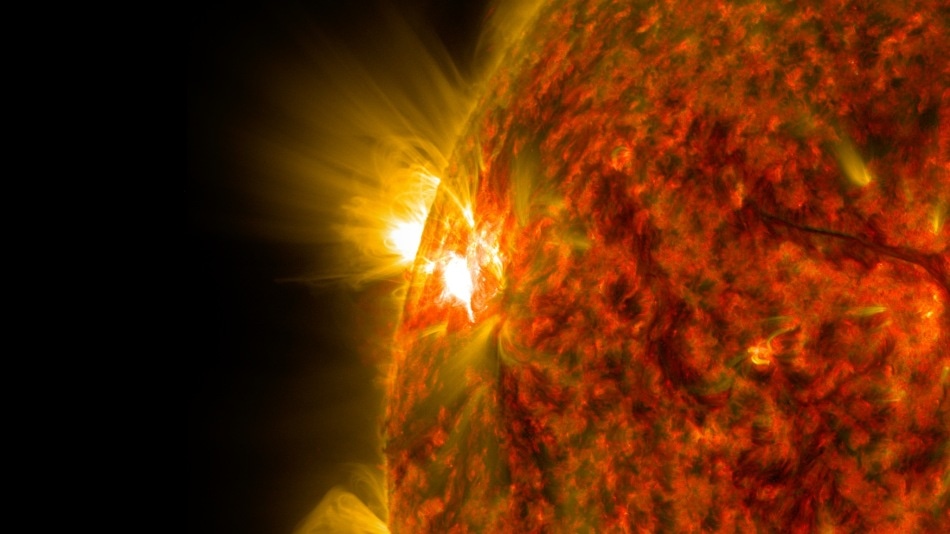Oct 30 2019
In the rotating plasma of the sun, a hitherto unnoticed mechanism is at work: a magnetic instability that was regarded by scientists as physically improbable under such conditions.
 The most sunspots and, thus, the greatest magnetic activity are located close to the solar equator. Scientists have now demonstrated for this region a specific magnetic instability that was considered impossible so far. (Image credit: NASA/SDO)
The most sunspots and, thus, the greatest magnetic activity are located close to the solar equator. Scientists have now demonstrated for this region a specific magnetic instability that was considered impossible so far. (Image credit: NASA/SDO)
This phenomenon might even have a critical role to play in the formation of the magnetic field of the sun, explain scientists from Helmholtz-Zentrum Dresden-Rossendorf (HZDR), the University of Leeds, and the Leibniz Institute for Astrophysics Potsdam (AIP) in the journal Physical Review Fluids.
Quite similar to a huge dynamo, the magnetic field of the sun is produced by electric currents. To gain better insights into this self-reinforcing mechanism, it is necessary for scientists to interpret the processes and flows in the solar plasma.
The magnetic field is produced by a combination of changing rotation speeds in various regions and intricate flows in the sun’s interior. During the process, strange magnetic effects can arise—similar to this newly discovered magnetic instability.
Scientists have named the recently detected unique case of magnetorotational instability (MRI) “Super HMRI.” It is a magnetic mechanism that makes the electroconductive, rotating gases and fluids in a magnetic field to turn unstable.
The unique feature of this case is that the Super HMRI necessitates precisely the same conditions that occur in the plasma close to the solar equator—the place at which astrophysicists detect the most sunspots and, hence, the Sun’s highest magnetic activity. However, until now, such an instability in the Sun was not detected at all, and is yet to be incorporated into models of the solar dynamo.
Magnetic Midwives
However, it is a well-known fact that magnetic instabilities have a critical role in various processes in the universe. For instance, planets and stars are formed by large rotating disks of gas and dust. This process would be unaccountable if there is no magnetic field.
Magnetic instabilities give rise to turbulence in the flows inside the disks and thus allow agglomeration of the mass into a central object. Similar to a rubber band, the magnetic field links neighboring layers rotating at varying speeds. It speeds up the slow particles of matter at the edges and makes the fast ones on the inside slow. At this point, the centrifugal force is not adequately strong and the matter collapses into the center.
Close to the solar equator, it behaves exactly in the opposite manner. The inner layers move more gradually compared to the outer ones. To date, experts had regarded this type of flow profile to be physically highly stable.
The scientists at HZDR, the University of Leeds, and AIP still made a decision to explore it more in-depth. When it comes to a circular magnetic field, they had already computed that even if gases and fluids were rotating faster on the outer side, magnetic instability could arise. But only under unrealistic conditions—the rotational speed must increase in an extremely strong way toward the outer edge.
Helical Instead of Circular
They tried another method, this time making their investigations based on a helical magnetic field. “We didn’t have any great expectations, but then we were in for a genuine surprise,” recollects Dr Frank Stefani from HZDR—since the magnetic instability can already arise if the speed between the rotating plasma layers increases only very little—which occurs in the region of the Sun very close to the equator.
This new instability could play an important role in generating the sun’s magnetic field. But in order to confirm it we first need to do further numerically complicated calculations.
Dr Frank Stefani, Helmholtz-Zentrum Dresden-Rossendorf
According to Prof. Günther Rüdiger of AIP, “Astrophysicists and climate researchers still hope to better understand the cycle of sunspots. Perhaps the ‘Super HMRI’ we have now found will take us a decisive step forward. We’ll check it out.”
The interdisciplinary research team has been using its different specialisms in astrophysics and magnetohydrodynamics to investigate magnetic instabilities—on paper, in the lab, and using advanced simulations—for over 15 years. The researchers intend to enhance physical models, gain insights into cosmic magnetic fields, and create novel liquid metal batteries.
In 2006, with the help of close collaboration, for the first time, they could experimentally demonstrate the theory of magnetorotational instability. Currently, they intend to perform the test for the special form they have predicted in theory: Through a large-scale experiment that is now being built in the DRESDYN project at HZDR, they intend to investigate this magnetic instability in the laboratory.